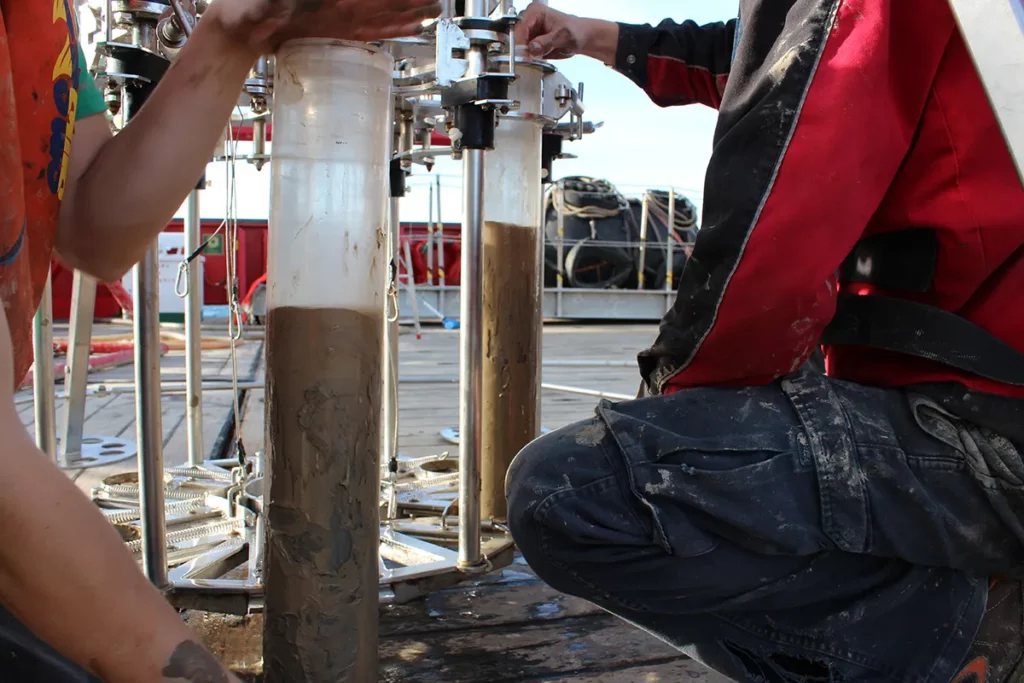
The world produces about 380 million metric tons of plastic annually. A huge share of plastic debris ends up in the world’s oceans, rivers, and lakes in the form of microplastics, contaminating countless ecosystems and threatening animals and humans.
A new study conducted in the Mediterranean Sea hints at the scale of the problem. Researchers found that the mass of particles that have settled to the seafloor mimics global plastic production over the past 5 decades. Once buried in sediment, the study found, microplastics remain intact.
Scientists have long scoured sediment cores—cylinders of mud drilled belowground and brought to the surface—for evidence of microplastic pollution in oceans, lakes, and other aquatic environments. The cores, they found, provide a timeline of the “plastic age,” the period starting in the 1950s when humans started producing the material on an industrial scale.
Plastic Fills Half a Century of Mediterranean Sediments
In the new study, researchers collected more than 10 cores from the seafloor of the Balearic Sea, a part of the Mediterranean near the Ebro delta, where one of Spain’s longest rivers enters the sea. The spot where the cores were collected, 100 meters (330 feet) below the surface, concentrates pollution discharged by the river, including plastic debris from bags, vessel paint, clothes, cosmetics, and other sources.
The researchers sliced the cores into 1-centimeter-thick (0.4-inch-thick) disks and used isotopic dating of lead naturally present in the sediments to estimate the age of five cores. Each slice encapsulated about 10 years of history.
The best-preserved core contained sediments from 1965. In this core, the researchers used spectrometers, which identify molecules by their different interactions with light, to measure the size and composition of the microplastics present. This equipment measured plastic particles down to 11 micrometers—the size of a red blood cell.
The researchers found that the mass of microplastics in the seafloor sediments had tripled in the past 20 years, and its accumulation followed the same trend observed in global plastic production. Among the most common plastics were polyethylene (the most commonly produced plastic), polypropylene, and polyester.

“We were surprised that the results fit so well with the global production,” said study coauthor Michaël Grelaud, a paleoceanographer at the Universitat Autònoma de Barcelona, in Spain. “The fact that we impact our environment is clear: We are capable of beautiful things that last thousands of years, but at the same time, in less than 70 years, we were able to distribute this plastic all around the world. It is sad.”
The study, published in Environmental Science and Technology, added to the understanding of the plastic problem, said ecosystem ecologist Javier Lloret from the Marine Biological Laboratory in Woods Hole, Mass., who was not part of the research.
“It is an interesting study because it provides evidence of contamination for a new kind of environment,” said Lloret, who has measured microplastics and found similar results in salt marshes in the United States. “All these depositional environments worldwide are telling us the same story: that this pollution is here to stay.”
An Ever Growing Pollution Problem
Although impressive, the level of contamination documented near the Ebro delta is considered intermediate. Previous studies have shown higher plastic concentrations in other parts of the world, and even other parts of the Mediterranean, such as the Tyrrhenian Sea off the west coast of Italy.
For Grelaud, the study’s most significant result is that the plastic in the cores did not show signs of breaking down. “Degradation happens when there is light or heat,” he explained. “We don’t have those in the sediment at the bottom of the sea, where it is dark and cold.”
Plastics can take anywhere from 20 to 400 years to decompose, depending on environmental conditions. Microplastics have been found in the air, water, soil, and even living organisms, including people. In the ocean, plastic pollution is expected to quadruple by 2050, according to a 2022 meta-analysis from the Alfred Wegener Institute Helmholtz Centre for Polar and Marine Research.
Scientists are still assessing the impacts of microplastics on ecosystems and human health. There are indications, however, that microplastics can harm organisms by accumulating in organs, physically blocking processes such as feeding, or causing cell death. The tiny particles also may act as vectors for toxins that can be dispersed throughout the food web.
“We are just starting to figure out the impacts” of microplastic pollution, Lloret said. But one thing is certain: As plastic production keeps increasing, it will only get worse.
This article originally appeared in Eos Magazine.


